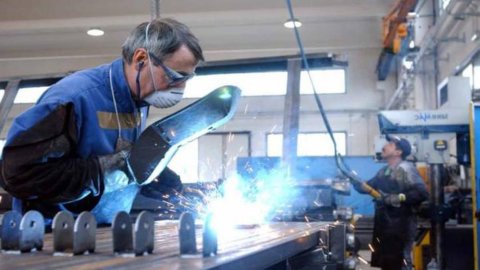Worldwide, employment has undergone significant changes, both in absolute values and in composition, on the occasion of each structural change in the economy. In the long run, however, total employment, as a percentage of the population, has grown everywhere. The use of machines over the last 150 years has also made a significant contribution to the decrease in weekly working hours per employee. In 1870 in Germany, Sweden and the United States the average length of the working week ranged between 62 and 70 hours, in 2015 the values had decreased by about half. The increase in free time has led to the creation of new industries, such as tourism which today directly and indirectly employs around 292 million people.
According to recent surveys, the use of already known new technologies will lead to a reduction of 2030 to 15% of human working hours worldwide by 30, or from 400 to 800 million fewer full-time equivalent workers. Overall, around 2.000 different tasks would be involved. The countries with the highest wages would be the ones most affected in a first phase. In the "medium speed" scenario, there would be a 26% contraction in hours worked in Japan, 24% in Germany and 23% in the United States. Along with the loss of jobs, it is likely that in the coming decades the greater automation of production processes will be one of the factors that will help displace tens of millions of workers to other sectors and create new jobs. All other things being equal, most of the new jobs should derive above all from the growth of the average incomes of the emerging countries, from the aging of the population and from investments in physical infrastructures and linked to the use of alternative energy sources.
Excluding the jobs lost due to automation, it is estimated that the growth of middle incomes in emerging countries could lead to a higher demand for consumer goods and services capable of creating between 300 and 350 million jobs globally by 2030.
Voices from the past
The coexistence between man and machine has never been easy. The theme of the threat that machines pose to the work and well-being of workers is not new but has developed over time together with the progress of the inventions themselves. In the eighteenth century, in the midst of the first industrial revolution, the Luddite movement in England spoke of machines as a tool useful only for saving on the work of the poor. Later, in the 1964s, JM Keynes coined the concept of "technological unemployment," and when computers began appearing in offices and robots in factories in the XNUMXs, Kennedy argued that the real challenge was to maintain full employment. in the United States at a time when machines were replacing humans. In XNUMX a group of Nobel Prize winners sent a memorandum to then US President Lyndon Johnson to warn him against the dangers of a revolution generated by the combined use of computers and automatic machines. Finally, in the XNUMXs, the advent of personal computers provoked a new, strong wave of protests for the loss of jobs that would have resulted from it.
Despite concerns, however, so far technology has ended up creating more jobs than it has destroyed. The automation of some processes has freed up human labor which has been re-used in completely new activities, such as the management of the machinery itself. In the United States, for example, during the 19th century, the amount of raw textile material produced in one hour using new machinery increased 50 times and the labor required to produce it decreased by 98%. However, the demand for textile products quadrupled, thanks to the reduction in the price of the raw material, thus generating new jobs. In general, both in developed and emerging countries, with each structural change in the economy, employment has undergone significant changes in absolute values and composition. In the United States, for example, the share of total employment employed in agriculture has fallen from about 58% in 1850 to 2,5% today, while manufacturing has gone from providing 25% of total employment in 1960 to just under by 10% today. The phenomenon can be seen in many other countries: in China, the sectoral recomposition has been quite rapid, and in just 25 years, agricultural workers have gone from 60% of the total (in 1990) to 28% (in 2015).
In the same period of time in Mexico it went from 52 to 13%, while in Japan from 31 to 3,5%, with manufacturing which, after reaching its maximum point in terms of employment in 1973 (25%), covers today a percentage of around 13%. Despite all this, total employment as a percentage of population has grown everywhere. The use of machines, on the other hand, has contributed significantly to the decrease in weekly working hours per employee observed over the last 150 years. In 1870 in Germany, Sweden and the United States, the average length of the working week ranged between 62 and 70 hours, while in the United Kingdom it was around 57. By 2015, the values had fallen by about half: 35 hours in Germany, Sweden and the UK and nearly 39 in the US. The increase in time off work has increased the demand for services and led to the creation of new industries, such as tourism, capable of creating millions of jobs. According to the World Tourism Organization, today the sector employs, directly and indirectly, 292 million people worldwide.
Jobs lost and jobs created. What's different today?
Although the automation of production processes is not, as has been said, a new phenomenon, the current phase nevertheless has some peculiarities: new technologies are not only able to replicate what we believe is possible for humans, but they are capable of carry out activities at a higher level and with a much wider potential diffusion than in the past. Furthermore, they are "indifferent to the color of the collars", i.e. they no longer involve only manual activities but, thanks also to the use of artificial intelligence, also those which concern the sphere of creativity. Their impact on employment will therefore be more significant. This leads to raise a fundamental question: what will be the consequences on human work (not only in quantitative but also qualitative terms)? What are the new occupations and skills required? The answers attempted so far are obviously conditioned by the time horizon considered and by the countries examined from time to time, but in general they all envisage a substantial reduction in employment in the short term, which would however be followed by the creation of new activities made possible, among the other, from the use of new tools and the demand deriving from the greater free time available.
According to the OECD, in the short term around 9% of current jobs will be (probably more than 70%) replaced by new automation processes. The percentages vary from a maximum of 12% in Austria, Germany and Spain to a minimum of 6% in Finland and Estonia; Italy has a value in line with the OECD average, as does France. A much higher percentage of jobs (about 25% on the OECD average) have a "medium" risk (50-70%) of complete automation, but are still subject to technological changes that will radically change the required tasks in the short term. In this case, Italy has one of the highest values (about 35%), followed by Germany, while slightly lower percentages are estimated for Spain and France. The tasks considered most at risk of being replaced by automation processes are above all those that require an elementary exchange of information, such as buying and selling, and simple manual skills. In the short term, occupations with a high component of creativity, those involving interpersonal relationships and involving skills relating to the emotional sphere and physical care of the person are considered safe from the "technological threat".
A study conducted by the University of Oxford on a sample of 702 occupations found that approximately 47% of workers in the United States are employed in tasks that have a high probability of being automated in the near future. Studies of other advanced countries (such as the UK and Japan) indicate similar percentages. An interesting research conducted by McKinsey at the end of 2017 on a larger sample arrives at somewhat similar results: depending on whether the change in the technological paradigm occurs at an "average or high" speed, it is estimated that by 2030 there will be a loss of hours of human work worldwide ranging from 15 to 30%, i.e. a reduction in full-time equivalent employment from approximately 400 to 800 million individuals. This with the sole use of already known technologies. Overall, around 2.000 different tasks would be involved. The impact will differ between sectors and countries: in the United States, for example, in manufacturing and retail, employees spend about a fifth of their working day performing repetitive physical activities that can already be replaced by known technologies . In manufacturing, tasks such as those of welding workers are 90% replaceable by automation, while in customer services the percentage drops to 30%.
According to the same research, the "labor cost" variable would initially be one of the main determinants in the decision to replace human labour, the countries with the highest wages would therefore be the ones most involved in this evolutionary path. In the "average speed" scenario (15% fewer hours worked globally by 2030) there would be a contraction in the number of hours worked equal to 26% in Japan, 24% in Germany and 23% in the United States. In emerging countries, the direct impact would be less: for example, it is estimated that in China the reduction in working hours caused by the automation of internal processes would be 16%, in Mexico 13% and in India 9%. However, for these countries the problem is more complex since the indirect effects must also be considered: the greater use of automation in developed countries discourages the outsourcing process, recomposes the production chains within individual countries and determines a loss of comparative advantage that the emerging have in labour-intensive productions.
This could lead, in the latter countries, to an early deindustrialization. Evidence of this phenomenon can in fact already be found: in the United Kingdom the manufacturing sector reached its maximum point, as a creator of employment, before the First World War, when it employed 45% of the employed, while it seems to have already reached its peak in countries such as Brazil, India and China, but at a much lower threshold (about 15%). This implies that the development model based on the movement of workers from agriculture to manufacturing will not be able to be followed by countries at an even lower level of development (for example some in South America and Africa) without however having been identified today an alternative one. Along with job losses, it is likely that increased automation will contribute to the displacement of a few tens of millions of workers to other sectors and the creation of new jobs in the coming decades. Although in a conservative scenario, i.e. without any assumptions relating to jobs created by new sectors (which in the past are estimated to have generated 0,5% of world employment each year), some estimates point to a substantial increase in employment .
All other things being equal, most of the new jobs should come from the growth of the emerging countries' middle incomes, from an aging population, from the need to improve human capital, with consequent higher demand for education, and from investments in physical and associated with the use of alternative energy sources. Excluding the jobs lost due to automation, the growth of
average incomes in emerging countries would in any case lead to a greater demand for consumer goods and services related to personal well-being. The latter would be able to generate around 300-350 million jobs globally by 2030. The greatest demand would go to sectors such as the automotive, recreational services, hospitality and catering, related goods to the use of free time, food, utilities and education. The contribution to employment from jobs linked to services made necessary by the aging of the population will also be very significant: by 2030 the world population should reach 8,5 billion people with an increase in the average age that will involve both countries both developed and emerging (China).
By that year there will be about 300 million more “over 65” individuals than in 2014; China, Germany, Italy and Japan will be the countries most affected by the phenomenon. The services made necessary by the care of this segment of the population worldwide could generate between 50 and 80 million full-time employees. Another 20-40 million could finally come from investments in physical infrastructure and related to the use of new energy sources.
Learn to relearn
The use of new technologies requires new skills and a new way of communicating them. The introduction of machines during the first industrial revolution had made it necessary to improve the ability to understand written texts and numerical calculations. Since then, the state has assumed almost everywhere the role of promoter of widespread universal education with a model that in some way replicated the methods and contents of the factory. The use of new technologies and artificial intelligence could today cause a break with the past both in the contents of training and in the way it is imparted and disseminated. With regard to the already employed workforce, today there is the problem of both measuring skills and verifying whether or not they are suitable for the new production context. The analyzes that quantify the consequences of the adoption of new technologies on employment are difficult to grasp the qualitative implications on the tasks performed. Experience in this case does not help because the current process is much faster than any other in the past and because the average life of working duties is substantially reducing: compared to apprenticeship courses that last 5 years or more , the required qualifications now have an average life of two to five years.
It then becomes fundamental to define learning paths that allow workers to acquire new skills, but above all allow them to "learn to re-learn", thus avoiding obsolescence. Curiosity and the ability to solve problems are two elements that future employee training programs will have to pay particular attention to. An analysis conducted by the OECD highlights the link between the skills of adult individuals (i.e. ability to solve problems, use ICT tools and applications for
access and manage information) and the likelihood of participating in the labor market. On average, the labor force participation rate is close to 90% for adults aged between 25 and 65 with high skills in these fields (level 2-3), it drops to 76% in the case of low-medium skills (below 1) and drops to 47% for individuals with no skills.
The difference between the three categories remains high even when referring to homogeneous groups of workers, for example those with a high level of education, or individuals belonging to the same gender. The differences appear particularly marked in the United Kingdom, Ireland, the Netherlands and Norway; other conditions being equal (education, gender, and so on) in these countries the labor market participation rate of those with advanced problem solving skills and the ability to use ICT tools is 17 pp higher than those with average skills, while that of those with minimal skills is 33 percentage points higher than those with no skills at all.





